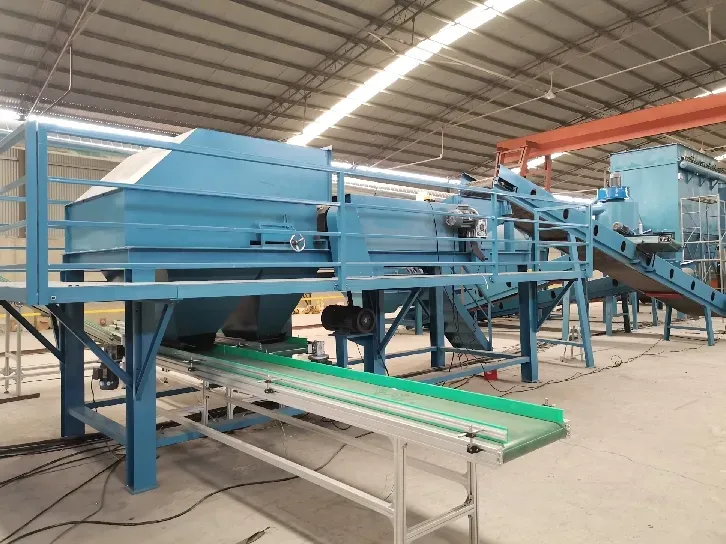
5 月 . 30, 2025 14:27 Back to list

(waste copper wire recycling machine)
The global electronics industry generates 50 million metric tons of e-waste annually, with copper wire scrap constituting over 15% of this stream. Recent International Copper Association data reveals that reclaiming copper through recycling requires 85% less energy than primary production, making advanced copper wire recycling machines indispensable for sustainable resource recovery. Contemporary processing plants utilizing automated granulator systems report 25-40% higher profitability compared to traditional manual stripping methods, driving 12% annual market growth for these technologies.
Modern copper wire granulators integrate multi-stage processing subsystems that achieve 99.9% metal purity through sequential separation techniques. The primary crushing phase employs hardened steel blades rotating at 1,200 RPM to shred cables into 10-15mm fragments, followed by vibrating density separators that isolate copper granules from plastic insulation. Advanced electrostatic separation modules then extract residual metallic particles using 25kV charge differentials, with infrared sensors continuously monitoring output quality. These systems now process up to 2,000kg/hour while consuming only 55kW/h per ton - a 65% energy efficiency improvement over first-generation models.
| Manufacturer | Throughput Capacity | Copper Recovery Rate | Power Consumption | Automation Level |
|---|---|---|---|---|
| ECO Green Equipment | 1,200 kg/h | 99.7% | 60 kW/h | Intelli-Sep™ AI Control |
| Granutech Saturn | 2,000 kg/h | 99.5% | 85 kW/h | Programmable Logic Controller |
| MG Recycling | 800 kg/h | 99.2% | 45 kW/h | Semi-Automated Operation |
| Doev Tech Systems | 1,500 kg/h | 99.8% | 70 kW/h | IoT Monitoring Integration |
Industrial operators should evaluate seven key parameters when investing in copper wire recycling equipment: metal recovery efficiency directly impacts revenue - each 0.1% increase represents approximately $28,500 annual additional profit for medium-scale processors. Throughput requirements must align with scrap inventory volumes, as underutilized machinery diminishes ROI on $150,000-$850,000 capital investments. Other critical considerations include installation footprint (minimum 50m² for integrated systems), available electrical infrastructure (380V-480V three-phase power), dust collection compliance certifications, and preventive maintenance costs averaging $18,000 annually for heavy-duty operations.
Leading manufacturers now offer modular designs enabling tailored configurations across multiple dimensions. For automotive harness processors, centrifugal separators with adjustable vortex controls extract copper from complex multistrand wiring. Operations handling PVC-insulated cables incorporate thermal processing modules to neutralize chlorine gas emissions, while facilities processing telecom wires integrate specialized magnetic separators for ferrous contamination removal. Power optimization packages can reduce consumption by 30% through regenerative braking systems that capture rotational energy during pulsing operations. These customizable options typically add 15-25% to base equipment costs but yield operational savings exceeding 40% in specific industrial applications.
A Bahrain-based e-waste facility increased copper recovery yields from 87% to 99.5% after implementing ECO Green's G-150 copper wire granulator machine, processing 18 metric tons of server cables daily while reducing labor requirements by 65%. In Germany, Scholz Recycling achieved zero-landfill status at their facility through integration of density separation technology that recovers and pelletizes plastic insulation for automotive parts manufacturing. Meanwhile, Urban Mine Solutions in California processes approximately 7,000kg/hour of mixed-gauge wiring using Doev's multi-stage separation system, automating material handling through robotic conveyor integration that reduced workplace injuries by 92% since installation.
The waste copper wire recycling sector continues evolving with near-infrared sensor technology now identifying and sorting distinct copper alloys at processing speeds exceeding 5ms per fragment. Global adoption of these technologies prevented an estimated 8 million metric tons of carbon emissions in 2023 alone according to the Global Recycling Council. Facilities integrating scrap metal recycling machinery with renewable energy infrastructure report complete energy neutrality when combining solar power arrays with advanced thermal recovery systems. As regulatory frameworks mandate higher recycling targets across 68 countries, the continuous improvement in waste copper wire recycling machine efficiency positions this technology as critical infrastructure for responsible resource management worldwide.

(waste copper wire recycling machine)
A: A waste copper wire recycling machine is specialized equipment designed to separate copper from insulation in discarded wires, enabling efficient recycling of valuable materials through processes like crushing and sorting.
A: A copper wire granulator machine shreds waste wires into small pieces, then uses air flow and vibration to separate copper granules from plastic insulation, ensuring high-purity metal recovery.
A: Most copper wire recycling machines handle various wire types, including automotive cables, communication wires, and household cables, as long as the diameter is within the machine's specified range.
A: Advanced machines achieve up to 99% copper recovery rates, minimizing material loss while producing clean, reusable copper granules and separated plastic residues.
A: Regular maintenance includes blade sharpening/replacement, dust removal, and lubrication of moving parts to ensure optimal performance and extend the machine's operational lifespan.
Latest news
Unveiling the Power of Eddy Current Separator
NewsSep.25,2024
Transform Your Home Recyclin:home metal shredder
NewsSep.25,2024
The Future of Waste Management with Recycling Line Picker
NewsSep.25,2024
The Benefits of a Metal Recycling Plant
NewsSep.25,2024
Revolutionize Material Separation with Onwang Technology
NewsSep.25,2024
Innovative Waste Management: Unveiling the MSW Sorting Plant
NewsSep.25,2024